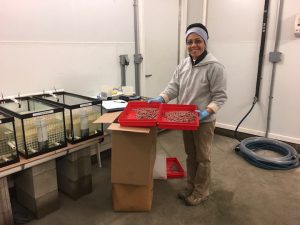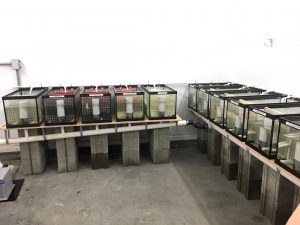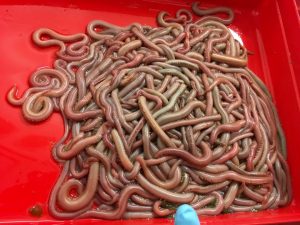Bloodworms Find a New Home at the CCAR
CCAR research associate, Luz Kogson, has begun a one-year trial that will assess the impact of substrate type on the culture of the bloodworm, Glycera dibranchiata.

Bloodworms are most commonly used as sport fishing bait, but these worms also have the potential to be used in other aquaculture applications, such as alternative feeds. They are currently the main component of many shrimp broodstock diets. Bloodworms fetch up to $15/kg, this, along with their future potential, makes them a good candidate for aquaculture production.
Today, 500 wild-harvested bloodworms, provided by Phil Harrington Bait in Woolwich, ME, were added to their new home, a 12-tank recirculating aquaculture system. The initial condition of the bloodworms have been evaluated, and they will now be exposed to various treatments. Their growth and condition will be periodically assessed throughout the trial.

Each tank is filled with either sand, synthetic media, or a mixture of the two. Sand is the closest to a bloodworm’s natural habitat, but it is difficult to deal with in a production scale land-based aquaculture system. Being able to successfully grow these worms using a synthetic substrate will greatly aid in the commercial production bloodworms, as it will be far easier to separate the worms from the substrate when it comes time to harvest the live worms for market. It will also be beneficial for the mechanical components of the recirculating system, as our pumps are built to move water, not sand.

In addition to the substrate trial, Amphipods are being produced in the same system alongside the worms and will be used as supplemental feed for the bloodworms throughout the trial. These small crustaceans eat macroalgae that is produced onsite in our mariculture lab.
The CCAR is well established in the polychaete culture techniques of the sandworm, Nereis virens, and it is our hope this knowledge translates to the production of this closely related species.
